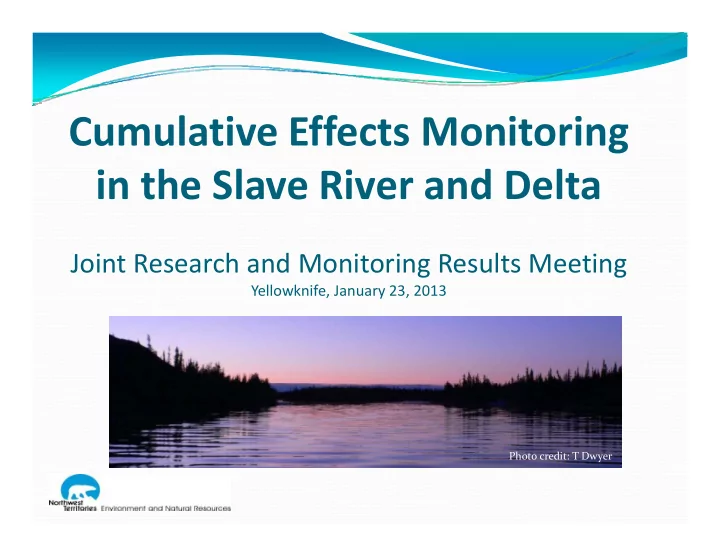

Cumulative Effects Monitoring i th Sl in the Slave River and Delta Ri d D lt Joint Research and Monitoring Results Meeting Yellowknife, January 23, 2013 Ph Photo credit: T Dwyer di T D Photo credit: T. Dwyer
Slave River and Delta Partnership (SRDP) Community concerns about the health of fish were brought forward to ENR Community concerns about the health of fish were brought forward to ENR • • during Fall 2010
Sl Slave River and Delta Partnership (SRDP) Ri d D lt P t hi (SRDP) Step 1: Conference calls with communities Aboriginal governments and Step 1: Conference calls with communities, Aboriginal governments and organizations, territorial and federal governments, and researchers to answer the following questions (Oct ‐ Nov 2010): What has been done before? Wh h b d b f ? • What is being done now? • Who is doing what? • What do communities want to do in the future? h d i i d i h f ? • How can we work together? •
Slave River and Delta Partnership (SRDP) Slave River and Delta Partnership (SRDP) Step 2: Aquatic ecosystem health indicators workshop (Fort Smith, March 2011) Participants identified concerns about potential effects of upstream development Can we drink the water? • Can we eat the fish? • Is the ecosystem healthy? •
Slave River and Delta Partnership (SRDP) Slave River and Delta Partnership (SRDP) Step 3: Slave River and Delta Partnership p p CIMP Project State of the Knowledge Report on the Slave State of the Knowledge Report on the Slave • • River and Slave River Delta What we know • Vulnerability Assessment and Prioritization Vulnerability Assessment and Prioritization • • Workshop (participation from both local and Traditional Knowledge holders and researchers) researchers) What we don’t know • What we want to know • What we want to work on first What we want to work on first •
Slave River and Delta Partnership (SRDP) Slave River and Delta Partnership (SRDP) Step 4: Monitoring and Research Sediment Core Sampling in Slave River • Delta to study contaminant concentrations over time (Wilfrid Laurier University) University) Fish health study and community fishing • days (Fort Smith and Fort Resolution) DFO Fish Health Study DFO Fish Health Study • • CIMP funded for furbearer (muskrat, mink • and beaver) population and contaminants project (1 st priority) Data are currently being analyzed and • released to the communities
Wh ’ i Who’s involved in the SRDP? l d i h SRDP? Members of: Deninu K’ue First Nation Fort Resolution & Fort Resolution & Town of Fort Smith Fort Smith Métis Councils Hamlet of Fort Resolution
Slave River and Delta Partnership (SRDP) and the C Canadian Water Network di W t N t k Canadian Water Network • CWN and GNWT Workshop (June 2012) monitoring experts and local and Aboriginal CWN and GNWT Workshop (June 2012) ‐ monitoring experts and local and Aboriginal • representatives provided input on developing an Aboriginal ‐ led community ‐ based cumulative effects monitoring program for the NWT, using the Slave River as a pilot program Based on the SRDP Vulnerability Assessment (Community Priority Questions) • Research teams must include experts on Hydrology, Water Quality, Fish and Benthic • Invertebrates, Human Dimensions of Aquatic Ecosystem Change and Community ‐ Based Monitoring Monitoring SRDP and science experts have reviewed EoQ’s, and two teams were invited to submit • full proposals (December 2012 Workshop)
Expectations for A Community Based Cumulative Expectations for A Community ‐ Based Cumulative Effects Monitoring Program A program that focuses on community • concerns, answers community questions and addresses cumulative impacts Research and monitoring that can be used • for decision ‐ making at multiple levels Collaborative, inclusive and participatory ‐ • meaningful community involvement at all stages in the project t i th j t A program that is cost ‐ effective and • d designed for long ‐ term community i d f l t it monitoring
NWT Wide Community ‐ based NWT Wide Community based Cumulative Effects Monitoring A framework that can be adapted and • implemented NWT wide if communities are interested Robust and integrative framework that • includes multiple aspects of aquatic ecosystem health, based on traditional and local knowledge and western science Will link with the existing water monitoring • programs and complement other research programs and complement other research and monitoring activities Will contribute to capacity building through Will contribute to capacity building through • collaborative research design, opportunities for training and community ‐ led sampling
Jennifer Fresque ‐ Baxter q Advisor, Watershed Management Jennifer fresque ‐ baxter@gov.nt.ca Jennifer_fresque baxter@gov.nt.ca Land & Water Division Land & Water Division Environment & Natural Resources Government of the Northwest Territories For more information about the NWT Water Stewardship Strategy and the Action Plan, visit the ENR website. Coming soon www.nwtwaterstewardship.ca!
Recommend
More recommend